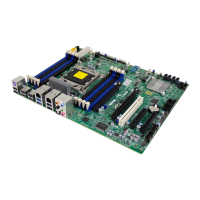
Do you have a question about the Supero X9SRA and is the answer not in the manual?
| Form Factor | ATX |
|---|---|
| CPU Socket | LGA 2011 |
| Chipset | Intel C602 |
| Memory Type | DDR3 |
| Memory Slots | 8 |
| PCIe 3.0 x16 Slots | 2 |
| PCIe 2.0 x1 Slots | 1 |
| SAS | 8 |
| Network | Dual Gigabit LAN |
| Audio | 7.1 Channel HD Audio |
| PCIe 2.0 x4 Slots | 1 |
| SATA III | 2 |
| SATA II | 4 |
| Storage Interfaces | SATA III, SAS |
| Expansion Slots | 1 x PCIe 2.0 x1 |
| USB Ports | 2 x USB 3.0 |
Details configuring SuperDoctor III for system monitoring and remote management.
Describes the structure of AMIBIOS flash chip and recovery process.
Guides BIOS recovery using a USB device.
Lists and describes various onboard headers and connectors with their pinouts.
Details the key hardware specifications of the motherboard, including CPU, memory, and expansion slots.
Provides precautions for handling components to prevent electrostatic discharge (ESD) damage.
Guides on installing the CPU and its heatsink onto the motherboard.
Details the process of installing a passive CPU heatsink.
Explains the procedure for safely removing a CPU heatsink from the motherboard.
Provides instructions for installing DDR3 memory modules into the motherboard slots.
Outlines the memory configurations and compatibility for the motherboard.
Recommends optimal memory module placement for performance.
Guides on mounting the motherboard into the computer chassis.
Identifies and explains the motherboard's rear I/O panel connectors.
Provides detailed pin assignments for front panel control connectors.
Details the procedure for clearing the system's CMOS settings.
Lists SATA/SAS connectors and their pin definitions for X9SRA-3.
Lists SATA connectors and their pin definitions for X9SRA.
Provides general procedures for troubleshooting system issues before and after power on.
Offers solutions for systems that power on but display no video output.
Guides on diagnosing and resolving memory-related issues.
Addresses problems with the system losing CMOS setup information.
Outlines steps to take before contacting technical support for assistance.
Guides on safely removing and installing the motherboard battery.
Introduces the AMI BIOS Setup Utility and its navigation.
Explains how to enter the BIOS setup utility during system boot.
Details various advanced BIOS settings for system configuration.
Accesses detailed CPU settings and information.
Configures CPU power-saving schemes and performance settings.
Allows configuration of various chipset settings.
Displays memory status and allows configuration of memory modes.
Selects the operating mode for installed SATA drives.
Configures settings for PCI, PCIe, and Plug-and-Play devices.
Protects against software attacks using Trusted Execution Technology.